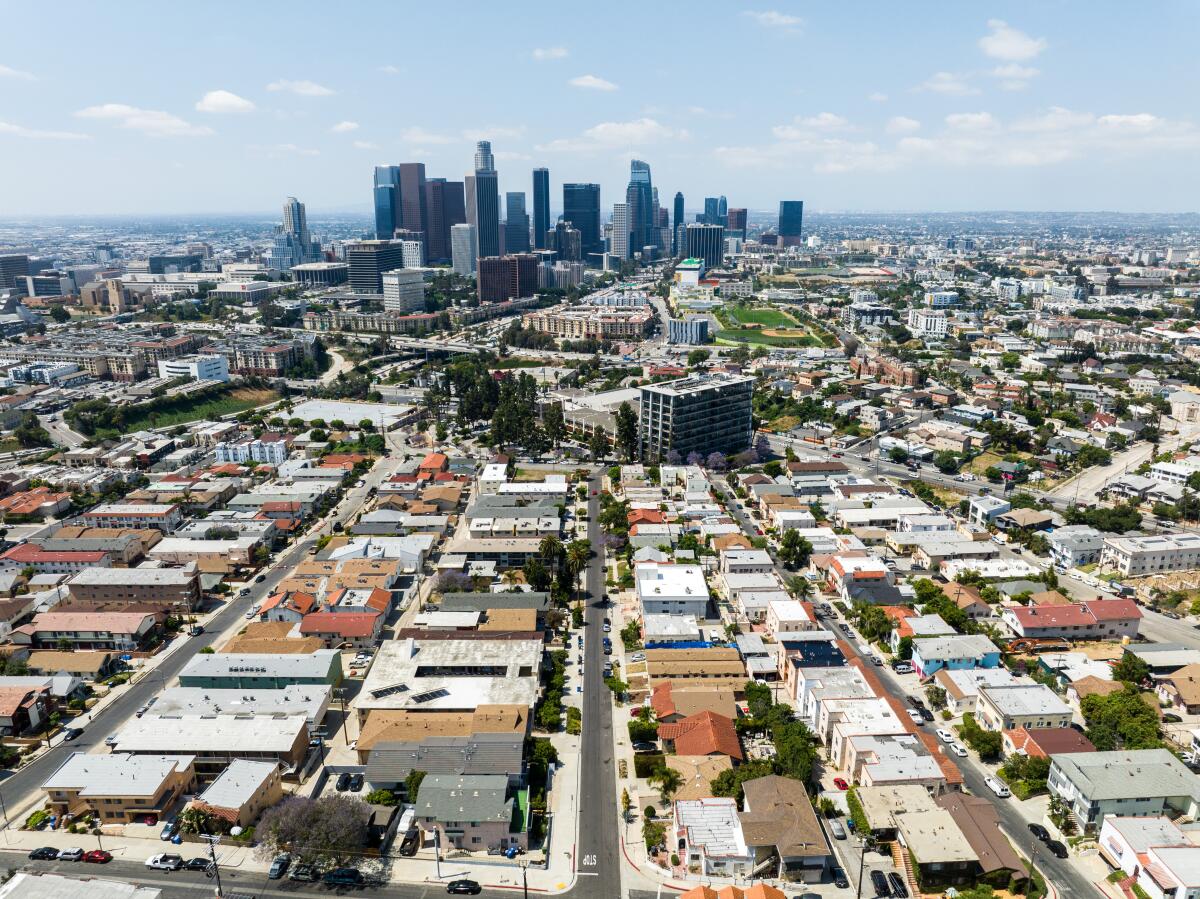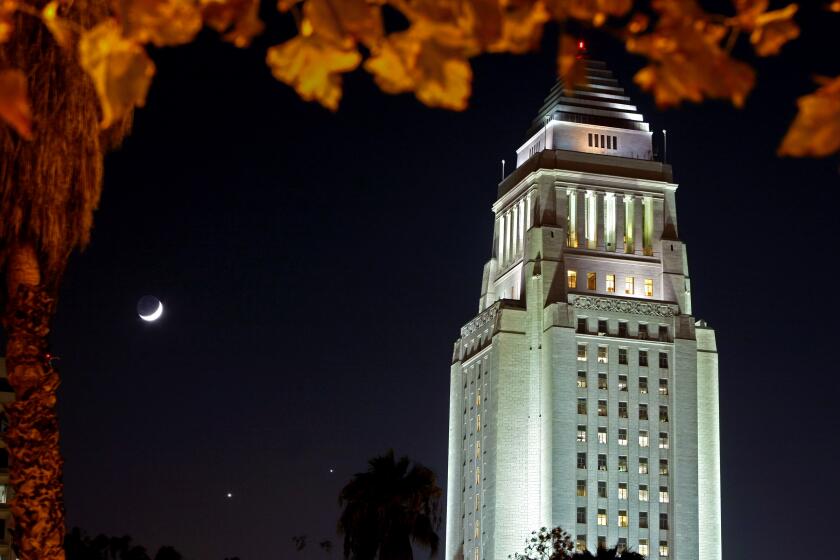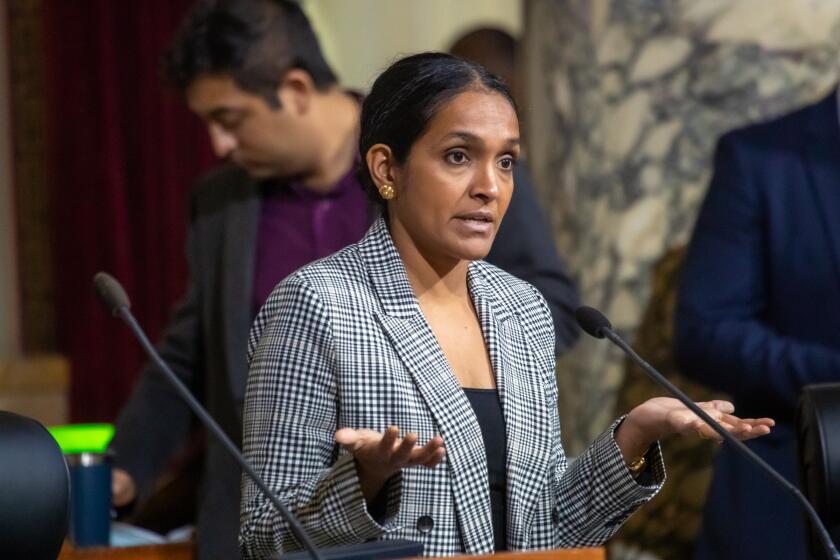If L.A. adds City Council seats, how would it work? These charts show the possibilities

- Share via
Beset by scandal — four criminal cases and the leak of an embarrassing secret audiotape in just four years — the Los Angeles City Council could take an important step toward transforming itself this week.
An ad hoc committee is expected to recommend broad outlines for expanding the council, a process that would slice the city’s 15 existing districts into smaller pieces and add an elected representative for each new segment. The council could more than double in size.
The goal is simple: to boost representation while discouraging unethical behavior. But does L.A. really need more government? At a potential cost of millions in taxpayer dollars?
“That’s a tough decision,” said Fernando Guerra, a political science professor at Loyola Marymount. “Not only for the city council but also for voters.”
Nearly a century has passed since L.A. residents approved the existing number of council seats. Since then, the population has swelled to 3.9 million, with each council member now representing about 265,000 residents. That’s far more than in cities such as New York (averaging 173,000) and Chicago (averaging 55,000).
Another way to look at it: Any two districts have roughly the same population as Wyoming, which is represented by a multitude of city councils, county boards, a state Legislature, two U.S. senators and a congresswoman.
“Los Angeles is a complex city, far more diverse than most cities in the United States,” said Gary Segura, a UCLA professor of public policy. “With huge numbers of ethnic and racial populations, it has become increasingly difficult to give different communities a voice.”
The push for expansion is hardly new to L.A., but ballot measures to add seats have failed three times in the last 50 years.
The latest effort is expected to focus on increasing the total number of seats to somewhere between 21 and 31. It was triggered by a spate of misbehavior that included separate criminal charges against council members Mitchell Englander, Mark Ridley-Thomas, Jose Huizar and Curren Price.
The audio recording that leaked to the public last year exposed Councilmembers Kevin de León, Nury Martinez and Gil Cedillo engaged in a conversation featuring racist and derogatory language as they strategized over redrawing district borders to benefit themselves or their allies. (Martinez and Cedillo are no longer on the council; De León remains and is running for reelection).
The council currently has 15 members, each of whom represent more than a quarter-million people.
Creating more council seats and reducing the average number of residents per district to as little as 128,000 could theoretically improve governance in several ways.
Depending on how districts are redrawn, such disparate neighborhoods as Boyle Heights and Eagle Rock, for example, might no longer be represented by the same elected official. Council members would have a better chance of presiding over what political scientists call “communities of interest” — areas that have similar needs and concerns.
At the same time, residents could get more help from their representatives when dealing with everyday issues such as trash collection and pothole filling.
“You’re not competing with as many other people,” said Raphael Sonenshein, executive director of the Haynes Foundation, which promotes social science research in the L.A. region. “It’s the ability to get your individual council member’s attention.”
Council members would have less individual sway with expansion, though not everyone would consider this beneficial. Some view the body’s current power as a counterbalance against the massive city bureaucracy.
Voters might not agree.
“You have more opportunities to hold [council members] accountable,” said Ange-Marie Hancock, a former USC professor who is now executive director at the Kirwan Institute at Ohio State. “It takes fewer votes to vote them out.”
Voters who support the idea of expanding the size of the L.A. City Council could end up waiting until 2032 for that change to go into effect.
For all the possible upside, there are potential downsides to expansion as well.
Cost is an issue that opponents often cite.
Each year, the city allocates $31.5 million to the council — $2.1 million for each district — mainly to cover staffing. Additional districts would require more employees, more office space, more cars, etc.
For 21 seats, the overall tab would rise to an estimated $44.1 million, an added annual cost of $12.6 million. For 31, the cost would be $65.1 million, an added $33.6 million.
“The truth of the matter is,” Segura said, “we spend very little on governance in Los Angeles.”
Proponents of expansion point out that even the latter expenditure would represent less than 1% of L.A.’s annual $13-billion budget.
The council could choose an alternate path by keeping overall spending at its present level and splitting it evenly among all districts. This could reduce each council office’s share by as much as half.
Of equal concern might be the question of efficiency. Or lack thereof.
More council members will almost certainly mean longer meetings, more bargaining and a tougher path to reaching consensus. Experts say that in Chicago and New York, which have 50 and 51 seats respectively, this model has helped concentrate power in the mayor’s office.
“I don’t think that’s in the cards for L.A.,” Sonenshein said. “Going to 30 or above is just too much.”
There is much work to do if L.A. is to get a larger council.
After the ad hoc committee delivers its proposal, deliberations will begin regarding the exact number of additional seats. A ballot measure could be ready for the 2024 election.
Then comes another decision.
The council could delay any changes until 2032, when the next regularly scheduled redistricting is set to take place. Or it could try for expansion as soon as 2026.
The L.A. Governance Reform Project — a sort of academics’ supergroup that includes Guerra, Sonenshein and others — is pushing for timely action. It has recommended additional measures.
An independent commission should be established to draw new district lines, avoiding any backroom dealing of the type exposed by the audiotape, the group’s interim report states. Stronger ethics rules and regulations should be part of the package.
Eventually, expansion will come before voters.
Given the failure of previous ballot measures, scholars believe any attempt to expand will need to earn the electorate’s trust.
“Folks are concerned that if we just make more of these positions,” group member Hancock said, “we’ll just get more of the same.”
More to Read
Sign up for Essential California
The most important California stories and recommendations in your inbox every morning.
You may occasionally receive promotional content from the Los Angeles Times.

















